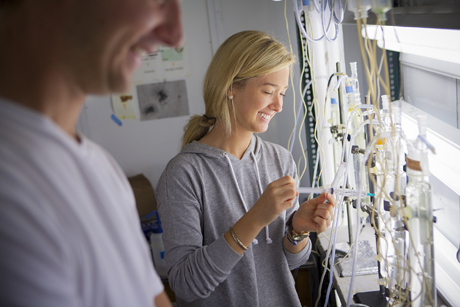Undergrads thrive in Hairston lab
By Linda B. Glaser

Paige Kulling ’14 peers into a beaker of algae, food for the Daphnia whose genes she studies in the lab of Nelson Hairston, the Frank H.T. Rhodes Professor of Environmental Science, for her honors thesis.
Daphnia – planktonic crustaceans – are ideal research subjects: Since their life cycle is only a week, Kulling can replicate her experiments many times over the summer to confirm her results. She’s studying DNA photorepair, trying to determine whether repairs to ultraviolet-damaged DNA in different environments are correlated with the expression of a photolyase gene (that encodes an enzyme that carries out the repair), or whether there’s another mechanism at work. She uses ultraviolet lamps to control the amount of radiation her subjects receive, the equivalent of a sunny day in shallow ponds in the Olympic Mountains of Washington state, where the animals naturally live.
While Kulling’s project won’t be completed for months, she presented a poster and gave a talk at Evolution 2013 in Snowbird, Utah, an annual conference for scientific research related to evolution.
“It brought me a lot of joy and satisfaction to see her thriving in that environment,” says Brooks Miner, a postdoctoral researcher in the lab, who had been mentoring Kulling and was at the conference. “She totally nailed her presentation; it couldn’t have been more perfect.”
Having worked in labs at other schools, Miner says he’s been “uniformly impressed” by the undergraduates in Hairston’s group. “They’re really responsible and take their work seriously,” he says.
Graduate students and postdocs play a critical mentorship role in Hairston’s lab. “Some of the best interactions and tightest relationships happen with someone closer to an undergraduates’ own age, going through the steps with them, mentoring them and by example showing them if they are considering an academic career how to move forward,” explains Hairston. “And it’s also important for graduate students to learn how to mentor well.”
Hairston makes a point to create opportunities for social time for those who work in his lab. For example, each summer, he organizes a lab outing to Watkins Glen, which includes a hike, picnic and go-kart racing.
Julie Geyer ’14 takes advantage of the short life span of another small animal, a rotifer, to study how different lineages evolve in response to the nitrogen content of their algal food resource. While her project takes place in the lab, she’s also helped fertilize algae with Hairston at the Cornell Experimental Ponds.
Hairston controls the nutrient quality of the algae in the ponds to see how it affects the Daphnia-algae predator-prey relationship in a natural environment. He’s working with four ponds this summer and has had some challenges restricting the amount of sunlight getting to the algae. He recently worked with Geyer and several other undergraduates to put polyethylene tubing around some swimming pool covers (like giant sheets of dark-colored bubble-wrap) to keep them from blowing into a pile against the shore. “It’s truly experimenting,” he says with a laugh.
In the past, Hairston has brought his undergraduates on scuba diving trips to Onondaga and Oneida lakes near Syracuse to look at how dormant eggs of zooplankton buried in the bottom sediments help in understanding how lake ecosystems respond to pollutants.
“The students in my lab are not bottle-washers,” he says. “They’re the ones looking through the microscopes, collecting and working with the data. And if they want to do their own project, I encourage them. I love it when you run into a student 10 years later, and they tell you how working in the lab turned them on to scientific research.”
Linda B. Glaser is staff writer for the College of Arts and Sciences.
Media Contact
Get Cornell news delivered right to your inbox.
Subscribe